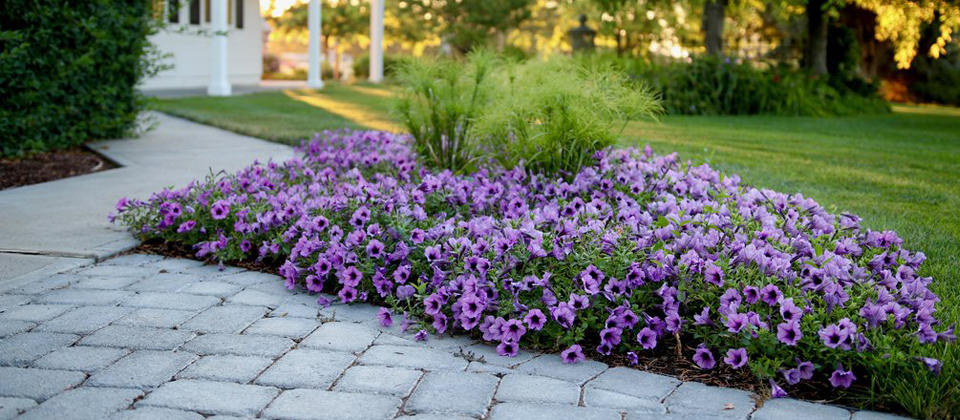HOW THE PLANT OF THE YEAR IS SELECTED
Candidates for the Proven Winners’ Plant of the Year are judged stringently by growers, retailers and home gardeners against the five criteria: Easy to Grow, Iconic, Readily Available, Perfect for Baskets or Containers and Outstanding Landscape Performance. Plants are selected that are easy for everyone to grow and deliver a clearly exceptional garden performance.
After several rounds of voting, the winners are announced to growers across North America one year in advance to ensure they have plenty of time to grow the millions of plants needed to satisfy the demand at retail. As a result, home gardeners can easily find a retailer who carries the winning Plants of the Year.
 ANNUAL OF THE YEAR: Supertunia® Bordeaux™ Petunia hybrid
ANNUAL OF THE YEAR: Supertunia® Bordeaux™ Petunia hybrid
Supertunia® Bordeaux™ will quickly grow into a blanket of sparkling purple flowers in your landscape. Since it is so vigorous, you won’t need many plants to make an impact. You’ll love how they look when you grow them in hanging baskets and upright containers. Supertunia® Bordeaux™ play well with others if you’re into playing matchmaker.
- Masses of vibrant color
- Non-stop bloom from spring to frost
- Self-cleaning flowers—NO deadheading needed
- Versatility of use in containers and landscapes
- Broad color range to suit every style
- Remarkable vigor and disease resistance
Supertunia petunias are vigorous with slightly mounded habits that function as both fillers and spillers in containers. They are also excellent landscape plants, best suited to be placed near the front of beds. They have medium to large sized flowers. Whether you’re looking to add a mass of color to your garden beds or create impressive containers with curb appeal, Supertunia® Petunias are the best choice for your sunny landscape. You’ll be amazed how green your thumbs are when you grow these vigorous, reliable flowers.
 PERENNIAL OF THE YEAR: Primo™ ‘Black Pearl’ Heuchera
PERENNIAL OF THE YEAR: Primo™ ‘Black Pearl’ Heuchera
Coral bells like Primo ‘Black Pearl’ tend to grow best and have the prettiest coloration when grown in part sun, meaning 4-6 hours of direct sunlight per day. In very warm climates, full shade may be necessary. In cooler zones, it will grow in full sun if given adequate moisture. Primo ‘Black Pearl’ will keep its dark coloration even in full sun conditions.
- Jet black, glossy, ruffled foliage
- Long lasting, light pink cut flowers
- Attracts pollinators like butterflies and hummingbirds
- Vigorous, densely mounding shape
- Versatile – grows in landscapes and containers
- Naturally heat and humidity tolerant
- Measures 8-10” tall x 26-30” wide
- Native perennial for zones 4-9
Coral bells like Primo ‘Black Pearl’ can be grown in containers, but keep in mind that it grows notably larger than standard varieties, so give it plenty of room to show off. If growing it on its own, choose a container that is at least 10” in diameter and 8” deep. If you plan to pair Primo ‘Black Pearl’ with other plants in a combination recipe, you’ll need a much larger pot, at least 18” in diameter.
 LANDSCAPE PLANT OF THE YEAR: Spilled Wine® Weigelia
LANDSCAPE PLANT OF THE YEAR: Spilled Wine® Weigelia
Rich, velvety foliage forms a sumptuous textural backdrop for a bright floral bouquet of magenta pink blossoms that sing every spring. An updated, more petite look for weigelia, it’s the perfect choice for foundation plantings, edging landscape beds and planting en masse. Full-bodied looks and an easy constitution—that’s Spilled Wine® weigelia.
- Dark wine red foliage all season
- Loads of vibrant magenta pink flowers in spring
- Attracts butterflies and hummingbirds
- Not preferred by deer
- Low mounding shape
- Adaptable to most soil types
- Grows in large containers and landscape beds
- Grows 2-3’ tall x 2-4’ wide
- Reliably hardy in zones 4-8
Like a complex wine, Spilled Wine Weigelia embodies a certain richness and intensity that may look complicated, but there’s really nothing to it. It even adapts to most soil types, including clay. Giving it 6+ hours of sunlight, average water (about an inch per week), and a bit of slow release tree and shrub fertilizer in early spring will do the trick.
Learn more about our National Plant of the Year program at www.nationalplantoftheyear.com.



